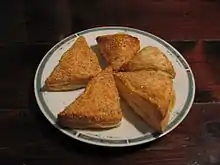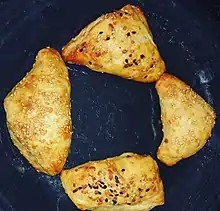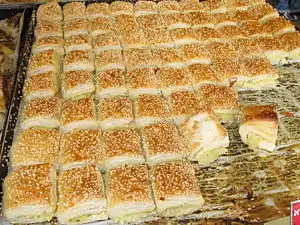Bourekas
Bourekas (Hebrew: בורקס) are a popular baked pastry in Sephardic Jewish cuisine and Israeli cuisine. Bourekas are made in a wide variety of shapes and a vast selection of fillings, and are typically made with either boureka dough, puff pastry, phyllo dough, or brik pastry, depending on the origin of the baker.[1]
 Typical Israeli bourekas, which are always topped with sesame, poppy or nigella seeds. | |
| Alternative names | Bourekasim, Bureka, Boureka, Burekas, Borekas, Burekasim |
|---|---|
| Type | Hors d'oeuvre, pastry, meze |
| Region or state | Israel (Sephardic Jewish cuisine) |
| Main ingredients | Boureka Dough, Puff pastry or phyllo; feta cheese, kashkaval cheese, mashed potato, spinach, mushrooms, pizza, less commonly ground beef, lamb, chicken, or vegetables, or a sweet filling such as halva/tehina |
Overview

Bourekas are often made out of puff pastry filled with various fillings. Among the popular fillings are feta cheese, kashkaval cheese, mashed potato, spinach and cheese, eggplant, pizza-flavor, and mushrooms.[2]
History
Early history
The Sephardic Jews of Spain made their own similar pastry, the empanada, for hundreds of years until they were persecuted and subject to forced conversion to Catholicism, sentenced to death, or forcibly expelled from Spain during the Spanish Inquisition which began in 1478.
In certain Italian towns of Emilia-Romagna[3] that were formerly city-states such as Ferrara and Modena, there is a half-moon shaped sweet pastry called burriche or burricche[4] which has been described as a mediaeval relic of the Ottoman inspired cuisine of the Jewish communities that lived in certain towns of the area. There can be distinguished the burriche ferraresi, to which grappa is being added and which are often filled with mandarin marmelade[5] and which are sometimes called in Ferrarese Ladino burichitas.[6][7] They resemble in shape and taste the Greek kourabiedes, which are pâte brisée like shortbreads that differ from their Middle Eastern counterparts by having also alcohol such as brandy or mastika added to them.
1478 to 1800s
The Sephardi Jews that were expelled from Spain sought refuge mainly in North Africa, the Balkans, and what is now Turkey, and the Levant.
Most of these places were under the control of the Ottoman Empire. As the Turkic tribes migrated from Central Asia to what is now Turkey to form the Ottoman Empire, they brought with them their cuisine. This included a dumpling called bureg. The name of this dish may have contributed to the name of bourekas. Bureg later evolved into a pastry called börek that was similar to the empanadas that Sephardic Jews had brought with them.[8]
The Sephardic Jews created a new dish which adapted börek to their kosher dietary laws, and combined it with their traditional empanadas to create bourekas.[9]
1800s to 1948
During the first aliyah Sephardic Jews made aliyah and moved to pre-state Israel. They brought with them their traditional cuisine, and this included bourekas. They began to open up bakeries serving these pastries.
1948 to present
The State of Israel declared independence in 1948, and with its independence a wave of pogroms, antisemitic attacks and riots against the local Jewish populations of the Middle East, followed by the mass expulsion of the Jewish population in a number of these countries, brought about the mass-migration of Sephardi Jewish refugees to Israel.
With the massive influx of Sephardi Jews, they too brought with them their cuisine and this included bourekas. Sephardic and Mizrahi cuisine became the dominant cuisine in Israel, due to the majority of Israelis belonging to these two groups, and due to the local climate.
Bourekas quickly became a very popular food across Israel, and their popularity spread to Israelis of all ethnicities. Yemenite and other Jews adapted bourekas to their own cuisines. Turkish Jews, Greek Jews and Bulgarian Jews, among others, opened eateries serving their own style and variations of bourekas.
Shapes

Israeli Bourekas come in a variety of shapes, which are indicative of their fillings. The laws of kashrut require avoiding eating dairy pastries together with ones containing meat, so conventional, distinctive shapes are used to indicate different types of fillings. Cheese Bourekas come in right angled and isosceles triangles, and have two different sizes. Potato-filled Bourekas come in a certain box shape. Pizza filled Bourekas resemble a co-centric tower, while spinach filled bourekas resemble a pastry knot. There are also the so-called "Turkish Bourekas" which form rounded equilateral triangles, and are filled with various fillings, whose type can usually be determined by the addition on their outside.
Shape regulation
In June 2013, the Chief Rabbinate of Israel passed a law regulating the shape of bourekas (and also rugelach and croissants) sold by kosher-certified bakers in Israel. According to the law, all bourekas made with puff pastry and containing dairy products had to be shaped into triangles, which parve (nondairy) bourekas made with puff pastry had to be made in round or square shapes. The Chief Rabbinate also implemented different regulations regarding the shape of bourekas made with phyllo dough, these bourekas must be made in triangular-shapes if parve (non-dairy), and ”snake-shaped” if made with dairy.[10]
Preparation
Traditionally making bourekas was a very time-consuming process, taking many hours on end until he bourekas were finished. Bourekas are traditionally made with freshly made enriched dough, either similar to puff pastry or phyllo depending on the origin of the baker, although brik pastry, malawach dough, puff pastry, croissant dough, or babka dough are also sometimes used. If homemade boureka dough is used, it involves a process of making s dough, rolling it out across a large surface, and then spreading a layer of butter or margarine across the dough. The dough is then folded several times, and placed in the refrigerator for either several hours or overnight. The dough is then removed from the refrigerator, it is rolled out and folded again; with this process being repeated several more times until the dough has developed enough distinct, flaky layers to be used for bourekas. Storebought frozen puff pastry or phyllo dough is more commonly used by home chefs today.[11]
The dough is then rolled out, and it is cut into various shapes. Any variety of fillings are placed into the center of each piece of dough, the edges of which are sealed with egg wash or water. Each boureka is then brushed with an egg wash and topped with seeds or seasoning, and is baked.[12]
Toppings

Bourekas are traditionally topped with any multitude of seeds. Sesame seeds are most common, however depending on the filling inside poppy seeds, black sesame seeds, everything bagel seasoning, nigella seeds, or za'atar may be used as a topping.
Serving
.jpg.webp)
Savory bourekas are traditionally paired with hard boiled eggs or haminados, a hot sauce such as skhug or harif, grated tomato, and sometimes tahini sauce, as well as olives, Israeli pickles, other pickled vegetables, and sometimes a salad as well. The use of skhug and grated tomato as an accompaniment to bourekas originated within the Yemenite Jewish community of Israel, who serve many of their traditional breads such as malawach in a similar manner.[13]
Popularity

The Jewish food historian and cookbook author Gil Marks has said, “In Modern Israel, borekas…follows only falafel in popularity as a street snack food and rank among the favorite home treats for the Sabbath or a simple weekday nosh.”[14]
Bourekas have been called ”the Israeli equivalent of Jewish-American bagel and cream cheese”, are served for almost any occasion such as a meeting of Israeli soldiers to Shabbat kiddush.[15]
Bourekas can be found everywhere in Israel. They are a very popular street food, and are served at shuks (outdoor markets) from eateries such as ”Giveret Bourekas” (“Mrs. Bourekas”) in the Machane Yehuda market in Jerusalem and ”HaBourekas Shel Ema” (“The Bourekas by Bubbe/Grandmother”, also known as “Penso Bourekas”) serving Turkish Jewish-style bourekas in the Levinsky market as well as the Carmel market in Tel Aviv. They are served Israeli chain restaurants and cafes such as Aroma Espresso Bar. They are also baked in dedicated boureka bakeries specializing in baking bourekas.[16] They are available at restaurants through Israel ranging from fine dining restaurants to gas stations and stands in the side of the road.[17]
Bourekas are also very commonly sold frozen in grocery and convenience stores in Israel[18] by brands such as Ta'amti and Tnuva in flavors such as cheese, spinach and cheese, potato, and pizza.[19]
In popular culture
Bourekas are a very popular Israeli food, and have been featured in popular culture.
- In the Israeli television series, Hashoter Hatov, bourekas are seen being eaten by several characters in the show.
Bourekas film
"Bourekas film" (Hebrew: סרטי בורקס sirtei burekas) are a type of Israeli movie from the 1970s dealing with certain cultural aspects of Israelis, especially lower-class Mizrahi Israelis and their conflicts with the Ashkenazi establishment. The term is a calque on Spaghetti Western.
See also
References
- Marks, Gil. The Encyclopedia of Jewish Food.
- "Mushroom & Feta Cheese Burekas". Sooo Good.
- "Enogastronomia emiliana e romagnola".
- Marks, Gil (17 November 2010). Encyclopedia of Jewish Food. Wiley. ISBN 9780470943540 – via Google Books.
- http://www.cuocazza.com/BURRICCHE_FERRARESI.html%5B%5D
- "Burriche".
- "Liquida - Cerca nel nuovo Liquida Annunci by Rubrikk". www.liquida.it.
- "Cheese bourekas with puff pastry". Zabar’s. Retrieved 21 October 2019.
- "Cheese Bourekas". Toriavey.com.
- "Rabbinate regulates bourekas shape". The Times of Israel. Retrieved 10 October 2019.
- Solomonov, Mike. Zahav. HMH.
- Shaya, Alon. Shaya. Knopf.
- Srulovich, Itamar. Golden.
- Marks, Gil. The Encyclopedia of Jewish Food. HMH.
- "How to Make Bourekas, Israel's Favorite Festive Pastry, Without the Hard Work". Haaretz. Retrieved 21 October 2019.
- "Finding The Best Bourekas On The Planet". The Forward. Retrieved 21 October 2019.
- Solomonov, Michael. Zahav: A World of Israeli Cooking. HMH.
- "What makes Israel Grocery Stores Unique". Haaretz. Retrieved 21 October 2019.
- Solomonov, Michael. Zahav.